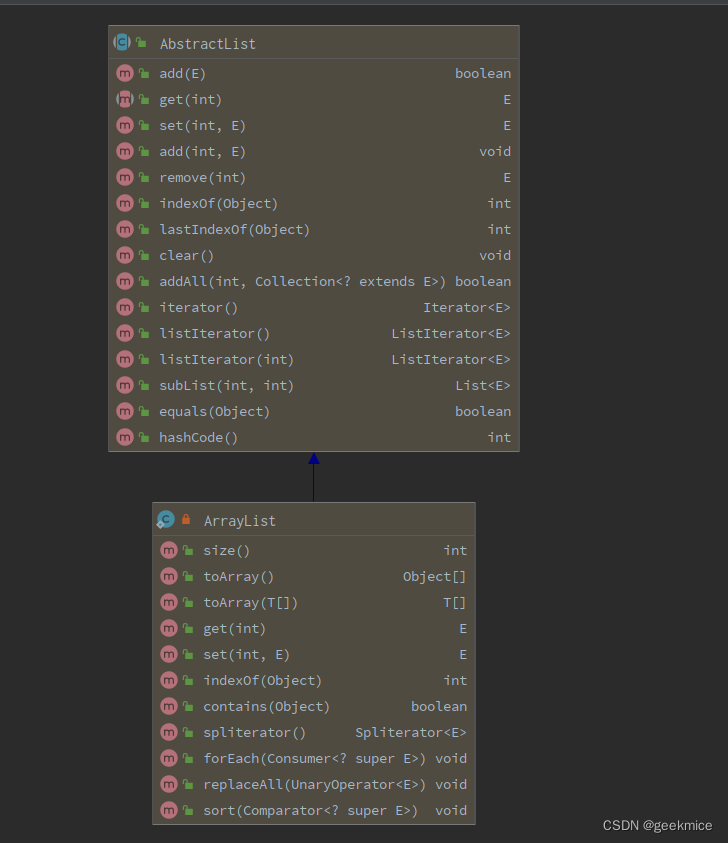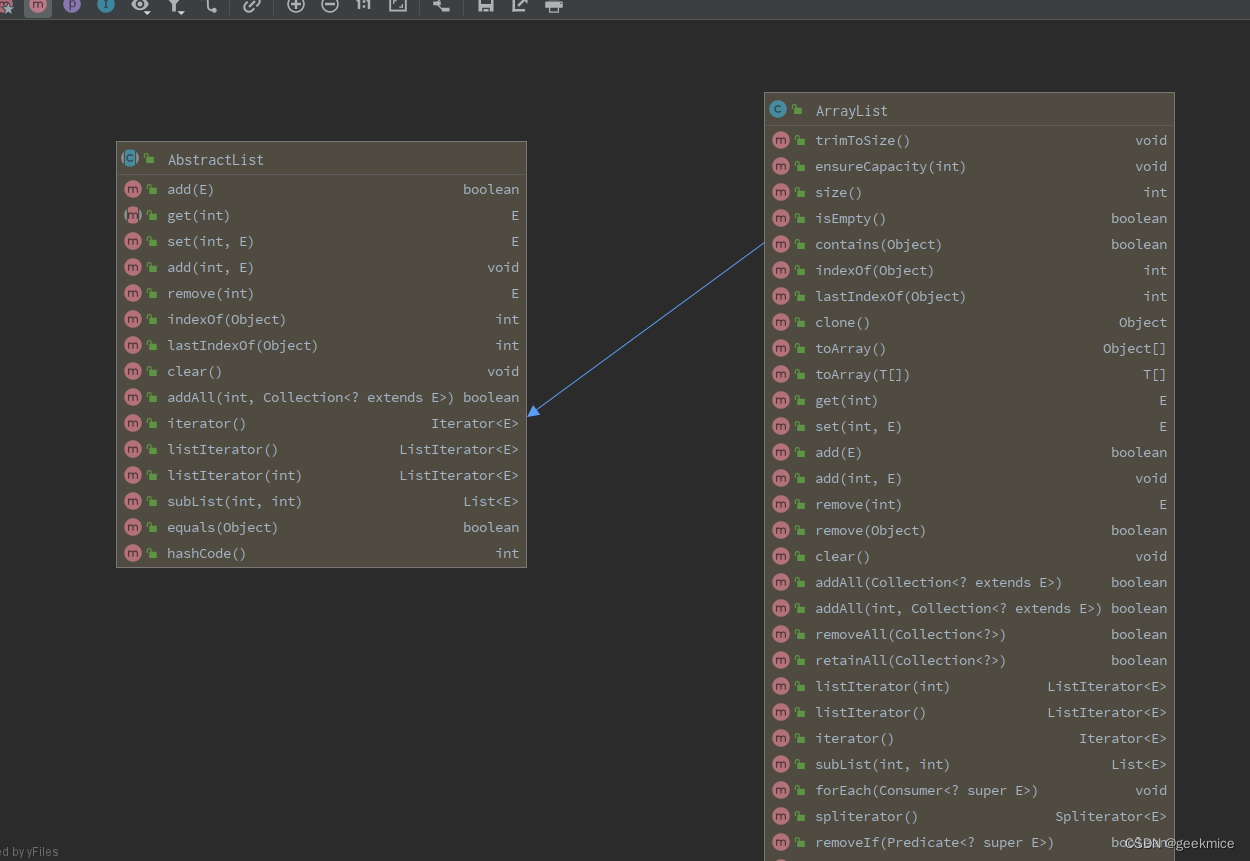-
list大坑请注意
问题一:Arrays.asList()返回的list不支持增删操作
问题复现
package com.geekmice.onetomany.list; import java.util.ArrayList; import java.util.Arrays; import java.util.List; public class ListTest { public static void main(String[] args) { t1(); } /** * @description 数组转换list */ public static void t1() { ArrayList<Object> objects = new ArrayList<>(); String[] array = {"张三", "李四", "王五"}; List<String> list = Arrays.asList(array); // Exception in thread "main" java.lang.UnsupportedOperationException list.add("小三"); } }- 1
- 2
- 3
- 4
- 5
- 6
- 7
- 8
- 9
- 10
- 11
- 12
- 13
- 14
- 15
- 16
- 17
- 18
- 19
- 20
- 21
- 22
- 23
错误提示
Exception in thread “main” java.lang.UnsupportedOperationException

分析:上面这几行代码,主要是将数组数组转换list,转换后list,进行添加操作提示错误 UnsupportedOperationException,刚开始很不解,Arrays#asList 返回明明也是一个 ArrayList,为什么添加一个元素就会报错?这以后还能好好新增元素吗;后面看了一下java.util.ArrayList和Arrays#asList 内部情况,其实不一样的;
对于Arrays#asList 而言@SafeVarargs @SuppressWarnings("varargs") public static <T> List<T> asList(T... a) { return new ArrayList<>(a); }- 1
- 2
- 3
- 4
- 5
发现这个Arrays#asList 返回的 ArrayList 其实是个赝品,仅仅只是 Arrays 一个内部类,并非真正的 java.util.ArrayList

从上图我们发现,add/remove 等方法实际都来自 AbstractList,而 java.util.Arrays$ArrayList 并没有重写父类的方法。而父类方法恰恰都会抛出 UnsupportedOperationException。public void add(int index, E element) { throw new UnsupportedOperationException(); }- 1
- 2
- 3
真正ArrayList,重写add,delete方法,可以正常使用

问题二:List,为什么却还互相影响
问题复现
public static void t2() { String[] array = {"张三", "李四", "王五"}; List<String> list = Arrays.asList(array); list.set(0, "001"); array[1] = "002"; System.out.println("array:" + Arrays.toString(array)); System.out.println("list:" + list); }- 1
- 2
- 3
- 4
- 5
- 6
- 7
- 8
效果展示
array:[001, 002, 王五]
list:[001, 002, 王五]从日志输出可以看到,不管我们是修改原数组,还是新 List 集合,两者都会互相影响。
查看 java.util.Arrays$ArrayList 实现,我们可以发现底层实际使用了原始数组@Override public E set(int index, E element) { E oldValue = a[index]; a[index] = element; return oldValue; }- 1
- 2
- 3
- 4
- 5
- 6
知道了实际原因,修复的办法也很简单,套娃一层 ArrayList 呗!
List<String> list = new ArrayList<>(Arrays.asList(arrays));- 1
public static void t2() { String[] array = {"张三", "李四", "王五"}; List<String> list = new ArrayList<>(Arrays.asList(array)); list.set(0, "001"); array[1] = "002"; System.out.println("array:" + Arrays.toString(array)); System.out.println("list:" + list); }- 1
- 2
- 3
- 4
- 5
- 6
- 7
- 8
array:[张三, 002, 王五]
list:[001, 李四, 王五]
不过这么写感觉十分繁琐,推荐使用 Guava Lists 提供的方法。List<String> list = Lists.newArrayList(arrays);- 1
引入依赖
<dependency> <groupId>com.google.guavagroupId> <artifactId>guavaartifactId> <version>22.0version> dependency>- 1
- 2
- 3
- 4
- 5
完善后代码
public static void t2() { String[] array = {"张三", "李四", "王五"}; ArrayList<String> list = Lists.newArrayList(array); list.set(0, "001"); array[1] = "002"; System.out.println("array:" + Arrays.toString(array)); System.out.println("list:" + list); }- 1
- 2
- 3
- 4
- 5
- 6
- 7
- 8
最终效果
array:[张三, 002, 王五]
list:[001, 李四, 王五]问题复现二
除了 Arrays#asList产生新集合与原始数组互相影响之外,JDK 另一个方法 List#subList 生成新集合也会与原始 List 互相影响;
public static void t2() { ArrayList<Integer> integerList = new ArrayList<>(); integerList.add(1); integerList.add(2); integerList.add(3); // Returns a view of the portion of this list between the specified List<Integer> subList = integerList.subList(0, 2); subList.set(0, 10); integerList.set(1, 20); System.out.println("integerList:" + integerList); System.out.println("subList:" + subList); }- 1
- 2
- 3
- 4
- 5
- 6
- 7
- 8
- 9
- 10
- 11
- 12
- 13
效果展示
integerList:[10, 20, 3]
subList:[10, 20]查看 List#subList 实现方式,可以发现这个 SubList 内部有一个 parent 字段保存保存最原始 List
public List<E> subList(int fromIndex, int toIndex) { subListRangeCheck(fromIndex, toIndex, size); return new SubList(this, 0, fromIndex, toIndex); } SubList(AbstractList<E> parent, int offset, int fromIndex, int toIndex) { this.parent = parent; this.parentOffset = fromIndex; this.offset = offset + fromIndex; this.size = toIndex - fromIndex; this.modCount = ArrayList.this.modCount; }- 1
- 2
- 3
- 4
- 5
- 6
- 7
- 8
- 9
- 10
- 11
- 12
- 13
- 14
所有外部读写动作看起来是在操作 SubList ,实际上底层动作却都发生在原始 List 中,比如 add 方法
出现OOM问题场景
private static List<List<Integer>> data = new ArrayList<>(); private static void oom() { for (int i = 0; i < 1000; i++) { List<Integer> rawList = IntStream.rangeClosed(1, 100000).boxed().collect(Collectors.toList()); data.add(rawList.subList(0, 1)); } }- 1
- 2
- 3
- 4
- 5
- 6
- 7
- 8
data 看起来最终保存的只是 1000 个具有 1 个元素的 List,不会占用很大空间。但是程序很快就会 OOM。
OOM 的原因正是因为每个 SubList 都强引用个一个 10 万个元素的原始 List,导致 GC 无法回收。
这里修复的办法也很简单,跟上面一样,也来个套娃呗,加一层 ArrayList
问题三:不可变集合,说好不变,你怎么就变了
为了防止 List 集合被误操作,我们可以使用 Collections#unmodifiableList 生成一个不可变(immutable)集合,进行防御性编程。
这个不可变集合只能被读取,不能做任何修改,包括增加,删除,修改,从而保护不可变集合的安全
问题复现
public static void t3() { ArrayList<String> list = new ArrayList<>(Arrays.asList("one", "two", "three")); List<String> unmodifiableList = Collections.unmodifiableList(list); // Exception in thread "main" java.lang.UnsupportedOperationException // 看起来没什么问题 unmodifiableList.add("1"); unmodifiableList.remove(1); unmodifiableList.set(0, "t"); // 以下进行测试 // list.set(0, "first_modify"); // Assertions.assertEquals(list.get(0), unmodifiableList.get(0)); // list.add("fourth"); // Assertions.assertEquals(list.get(3), unmodifiableList.get(3)); // Assertions.assertEquals(list.size(), unmodifiableList.size()); }- 1
- 2
- 3
- 4
- 5
- 6
- 7
- 8
- 9
- 10
- 11
- 12
- 13
- 14
- 15
效果展示

上面单元测试结果将会全部通过,这就代表 Collections#unmodifiableList 产生不可变集合将会被原始 List 所影响。分析
查看 Collections#unmodifiableList 底层实现
UnmodifiableList(List<? extends E> list) { super(list); // 这里面引入原始list this.list = list; }- 1
- 2
- 3
- 4
- 5
可以看到这跟上面 SubList 其实是同一个问题,新集合底层实际使用了原始 List。
解决方案
使用 JDK9 List#of 方法。
List<String> list = new ArrayList<>(Arrays.asList("one", "two", "three")); List<String> unmodifiableList = List.of(list.toArray(new String[]{}));- 1
- 2
使用 Guava immutable list
List<String> list = new ArrayList<>(Arrays.asList("one", "two", "three")); List<String> unmodifiableList = ImmutableList.copyOf(list);- 1
- 2
相比而言 Guava 方式比较清爽,使用也比较简单,推荐使用 Guava 这种方式生成不可变集合。
问题四:foreach 增加/删除元素大坑
问题复现
public static void t4(){ String[] array = {"1","2","3"}; ArrayList<String> list = new ArrayList<>(Arrays.asList(array)); for (String s : list) { if("1".equals(s)){ // Exception in thread "main" java.util.ConcurrentModificationException list.remove(s); } } }- 1
- 2
- 3
- 4
- 5
- 6
- 7
- 8
- 9
- 10
- 11
上面代码我们使用foreach方式遍历list集合,如果符合条件,将会从集合中删除该元素;
这个程序编译正常,但是运行时候,程序异常,日志如下效果展示
Exception in thread “main” java.util.ConcurrentModificationException
at java.util.ArrayList I t r . c h e c k F o r C o m o d i f i c a t i o n ( A r r a y L i s t . j a v a : 901 ) a t j a v a . u t i l . A r r a y L i s t Itr.checkForComodification(ArrayList.java:901) at java.util.ArrayList Itr.checkForComodification(ArrayList.java:901)atjava.util.ArrayListItr.next(ArrayList.java:851)
at com.geekmice.onetomany.list.ListTest.t4(ListTest.java:67)
at com.geekmice.onetomany.list.ListTest.main(ListTest.java:14)
分析
可以看到最终错误是由ArrayList$Itr.next处代码抛出,但是代码中我们并没有调用,为什么呢?
实际上这是foreach方式给java提供语法糖,编译后编程另外一种方式,反编译看一下public static void t4() { String[] array = new String[]{"1", "2", "3"}; ArrayList<String> list = new ArrayList(Arrays.asList(array)); Iterator var2 = list.iterator(); while(var2.hasNext()) { String s = (String)var2.next(); if ("1".equals(s)) { list.remove(s); } } }- 1
- 2
- 3
- 4
- 5
- 6
- 7
- 8
- 9
- 10
- 11
- 12
- 13
可以看到foreach这种方式实际就是迭代器Iterator实现的,这也就是foreach被遍历的类需要实现Iterator接口的原因

看到modCount 和expectedModCount不同才错误,再看看这两个属性什么含义int cursor; // index of next element to return int lastRet = -1; // index of last element returned; -1 if no such int expectedModCount = modCount;- 1
- 2
- 3
public boolean remove(Object o) { if (o == null) { for (int index = 0; index < size; index++) if (elementData[index] == null) { fastRemove(index); return true; } } else { for (int index = 0; index < size; index++) if (o.equals(elementData[index])) { fastRemove(index); return true; } } return false; } /* * Private remove method that skips bounds checking and does not * return the value removed. */ private void fastRemove(int index) { modCount++; int numMoved = size - index - 1; if (numMoved > 0) System.arraycopy(elementData, index+1, elementData, index, numMoved); elementData[--size] = null; // clear to let GC do its work }- 1
- 2
- 3
- 4
- 5
- 6
- 7
- 8
- 9
- 10
- 11
- 12
- 13
- 14
- 15
- 16
- 17
- 18
- 19
- 20
- 21
- 22
- 23
- 24
- 25
- 26
- 27
- 28

modCount 来源于 ArrayList 的父类 AbstractList,可以用来记录 List 集合被修改的次数
modCount 计数操作将会交子类自己操作,ArrayList 每次修改操作(增、删)都会使 modCount 加 1解决方案
使用迭代器删除
String[] array = {"1","2","3"}; ArrayList<String> list = new ArrayList<>(Arrays.asList(array)); Iterator<String> iterator = list.iterator(); while(iterator.hasNext()){ String str = iterator.next(); if(str.equals("1"){ iterator.remove(); } }- 1
- 2
- 3
- 4
- 5
- 6
- 7
- 8
- 9
使用removeIf删除
String[] array = {"1","2","3"}; ArrayList<String> list = new ArrayList<>(Arrays.asList(array)); list.removeIf(str->str.equals("1"));- 1
- 2
- 3
总结
第一、Arrays.asList和List.subList就是一个普通独立的ArrayList
如果没有办法,使用了Arrays.asList和List.sublist,返回给其他方法时候,一定要嵌套真正的ArrayList
第二、jdk提供的不可变集合非常笨重,低效,不安全,推荐使用guava不可变集合
第三、不要随便在foreach增加/删除元素 -
相关阅读:
django ModelForm文件上传(八)
Java从零学起(十二)----HashSet集合
Go-知识并发控制mutex
Uniapp实现APP云打包
Pisa-Proxy 之 SQL 解析实践
【store商城项目02】登录功能的开发
移动端异构运算技术 - GPU OpenCL 编程(基础篇)
MongoDB-入门
CentOS 7 源码制作ngnx-1.22.1-ipv6 rpm —— 筑梦之路
Json详解
- 原文地址:https://blog.csdn.net/greek7777/article/details/126334416
